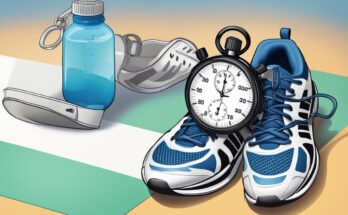Running is a popular form of exercise that many people engage in for its health benefits, stress reduction, and the joy of being outdoors. However, the weather doesn’t always cooperate with a runner’s schedule. Inclement conditions such as rain, snow, heavy winds, and extreme temperatures present a unique set of challenges to those who prefer to get their miles in the open air. Runners must therefore be adaptable, equipping themselves with the right gear and knowledge to safely navigate less-than-ideal weather.

Weather poses numerous hurdles for outdoor runners. Slippery surfaces, reduced visibility, and the risk of hypothermia or heat exhaustion require consideration and planning. Runners must understand how to adjust their pace, form, and clothing to maintain performance while preventing injuries and illnesses associated with harsh weather conditions.
Adapting to bad weather also provides an opportunity for mental growth and resilience. Running in challenging conditions can sharpen a runner’s mental toughness, teaching them to push through discomfort and remain committed to their training goals. Proper preparation enables runners to confront and overcome the obstacles presented by a wide range of weather scenarios.
Understanding Weather Impacts on Running
Weather conditions significantly influence a runner’s performance and physical reaction to exercise. Variables such as temperature, humidity, and wind chill affect bodily functions like blood flow and metabolism, which are critical to a runner’s endurance and speed.
Effects of Temperature on Performance
Temperature has a direct impact on a runner’s body. Optimal performance is often achieved in mild temperatures, where body composition and heat dissipation are balanced. As temperatures rise or fall, runners may experience a decrease in performance due to physiological strain.
- Warm temperatures increase body temperature, leading to faster dehydration and a higher heart rate.
- Cold temperatures can reduce blood flow and muscle elasticity, affecting a runner’s efficiency and increasing the risk of injury.
Humidity and Running
Humidity interacts with temperature to shape a runner’s experience. When humidity is high, perspiration does not evaporate as effectively, impeding the body’s ability to cool itself. This can lead to:
- Overheating
- Exhaustion
- Reduced metabolism efficiency
| Humidity Level | Effect on Body | Performance Impact |
|---|---|---|
| High | Decreased cooling | Lower endurance |
| Moderate | Manageable cooling | Slight decrease in performance |
| Low | Effective cooling | Optimal performance |
Wind Chill and Running
Wind chill describes the cooling effect of wind on a person’s perceived temperature, especially when running in cold weather. It can sharply increase the chances of hypothermia and frostbite by accelerating heat loss from the body. Runners need to consider wind chill since it can:
- Increase the body’s workload to maintain core temperature
- Affect respiratory function due to cold air intake
Protection against wind chill includes layers of clothing and minimizing exposed skin. Adjusting pace and distance according to wind conditions is also necessary to maintain performance and safety.
Preparation for Running in Bad Weather

When setting out for a run in challenging weather conditions, runners should check the weather forecast to plan accordingly, select appropriate gear to stay comfortable and dry, and understand layering techniques to regulate body temperature.
Weather Forecast and Running Plans
Before lacing up their running shoes, runners should consult the weather forecast to make informed decisions about their route and timing. It is crucial to identify if there are any weather advisories that may impact their run. Adjusting the distance and pace can help runners to manage their efforts and expectations during unfavorable weather conditions.
Choosing the Right Running Gear
Selecting suitable running gear is essential for safety and comfort. Runners should opt for:
- Running shoes with good grip to prevent slips on wet surfaces.
- Running tights or pants that provide mobility and protection.
- Moisture-wicking fabric for inner layers to help keep the skin dry.
- A protective jacket that shields against wind and rain.
- Gloves and a neck gaiter for warmth in cold conditions.
- Technical fabric socks, preferably without cotton, to reduce the risk of blisters.
Layering Principles for Temperature Management
Understanding how to effectively layer clothing can make a substantial difference. Runners should:
- Start with a base layer made of moisture-wicking fabric to keep sweat away from the body.
- Add an insulating layer to retain heat.
- Top with a breathable, water-resistant outer layer.
Runners may also pack extra dry clothes to change into post-run, ensuring they maintain their body heat and comfort once they stop running.
Safety Measures and Injury Prevention

When running in adverse weather conditions, safety and injury prevention are paramount. Runners should be aware of the challenges posed by low visibility, slippery surfaces, and temperature extremes. Recognizing these challenges is the first step to mitigating risk.
Dealing with Low Visibility and Slippery Surfaces
- Visibility: To enhance visibility, it’s crucial to wear reflective clothing and use lights when running in fog, rain, or snow. Reflective armbands and headlamps can make runners more visible to others and help them see obstacles in their path.
- Slippery Surfaces: To prevent slips and falls, opt for shoes with non-slip tread and be cautious on wet or icy surfaces. Shortening your stride can improve stability and reduce the risk of injury.
Cold-Related Health Risks and Prevention
- Frostbite: Frostbite can occur on exposed skin in cold, windy weather. Wearing layers of moisture-wicking clothes and protecting extremities with hats, gloves, and socks will help prevent skin damage.
- Hypothermia: Hypothermia is a danger when the body’s temperature drops significantly due to cold, wet conditions. Prevent it by wearing waterproof gear and avoiding cotton, which loses its insulating properties when wet.
Running Safely in the Rain
- Chafing: Water can increase the risk of chafing. To safeguard the skin, apply body glide or vaseline to chafe-prone areas before heading out.
- Health: Running in the rain can be safe, but caution is advised for those with weakened immunity systems or cardiovascular disease. Always listen to your body and adjust your workout accordingly.
Adjusting Your Running Routine
Adjusting one’s running routine in bad weather ensures the maintenance of progress without compromising safety or motivation. Adapting workouts, finding indoor alternatives, and sustaining mental health are crucial considerations.
Altering Workouts and Training Plans
When the weather turns inclement, runners may need to change the intensity or duration of their runs. For marathon training or longer distances like a half marathon, it’s important to prioritize long-run endurance without risking injury. If facing extreme conditions, it’s wise to shorten the training session and focus on maintaining fitness rather than pushing for performance gains. A 5k or 10k plan might incorporate more speed work or tempo runs that can be adjusted in length but kept at a similar intensity.
- Goals: Adjust to maintain, not improve, current fitness levels.
- Training Plan Modifications:
- Marathon/Half-Marathon: Shorten long runs; add rest days.
- 5k/10k: Modify speed work duration; maintain intensity.
Indoor Running Alternatives
For days when outdoor running isn’t practical, indoor alternatives can provide effective training options. Using a treadmill can simulate outdoor running and allow for specific incline and speed settings that can match a training plan. Cross-training with cycling, swimming, or elliptical workouts can maintain cardiovascular fitness without the impact stress of running.
- Treadmill Workouts:
- Adjust incline to mimic outdoor terrain.
- Utilize pre-programmed workouts for variety.
- Cross-Training: Incorporate for reduced impact on joints.
Maintaining Motivation and Mental Health
Bad weather can challenge a runner’s motivation and potentially contribute to seasonal affective disorder. To combat this, they can establish a routine that includes regular exposure to daylight to help with vitamin D production. Setting small, achievable goals can keep motivation high, and staying connected with a running community or group can provide the necessary support.
- Mental Health Strategies:
- Seek daylight for vitamin D.
- Set achievable short-term goals.
- Community:
- Join indoor running groups or participate in virtual challenges.
Physical and Psychological Benefits
Running in less-than-ideal weather conditions, such as during the cold and wet months, can still yield significant physical and psychological benefits for individuals.
Boosting Metabolism and Immune System
Metabolism: Cold-weather running can stimulate metabolism. Specifically, it encourages the body to generate heat through an increase in metabolic rate. This process involves brown fat, a type of fat tissue that burns calories to maintain body temperature.
- Brown Fat Activation: Exposure to cold during winter running prompts brown fat to convert food into body heat, positively impacting metabolism.
- Immune System Enhancement: Regular physical activity, despite adverse weather conditions, strengthens the immune system. It makes the body more efficient at fighting off infections.
Building Mental Resilience
Engaging in physical activity such as running during challenging weather conditions requires and builds mental resilience.
- Adaptability: Runners who consistently train in bad weather develop a psychological edge, learning to adapt to discomfort and unpredictability.
- Stress Reduction: The act of overcoming the initial resistance to adverse conditions has been shown to reduce stress, lending a sense of achievement and fortitude.
Post-Run Recovery and Care
After braving inclement weather during a run, taking the right steps for recovery and care is vital for a runner’s well-being and the durability of their gear.
Effective Cool-Down and Hydration
A structured cool-down routine helps to gradually reduce heart rate and aids muscle recovery. Runners should start by walking for 5-10 minutes to transition the body from intense running to a state of rest. Next, they might perform gentle stretches for all major muscle groups, holding each stretch for about 15-30 seconds to assist with flexibility and reduce the risk of injury.
Hydration is equally critical post-run, especially after running in harsh weather conditions. Runners need to replenish fluids lost through sweat; therefore, they should aim to drink at least 16 ounces (approximately 500 ml) of water or a sports drink with electrolytes within 30 minutes after finishing their run.
| Post-Run Hydration Checklist | Quantity | Timing |
|---|---|---|
| Water | At least 16 oz | Within 30 min post-run |
| Sports Drink (if preferred) | At least 16 oz | Within 30 min post-run |
| Additional fluids | To thirst | Ongoing post-run |
Clothing Care and Longevity
To maintain the integrity of their running attire, runners should prioritize the care of their technical and moisture-wicking fabrics immediately after a run. These garments should be turned inside out before washing to protect the material. It’s advisable to use a gentle cycle and mild detergent, avoiding fabric softeners or bleach, as they can break down the fibers and diminish the moisture-wicking properties.
Drying should be done on a low setting or by air-drying. High heat can damage technical fabrics, reducing their life span and effectiveness. Following these steps helps ensure that the clothing retains its shape, function, and comfort for future runs.
| Clothing Care Steps | Procedure |
|---|---|
| Pre-Wash | Turn inside out |
| Washing | Gentle cycle with mild detergent |
| Drying | Low heat or air-dry |
| Fabric Softeners or Bleach | Avoid to preserve fabric quality |
Runner’s World Insights and Expertise
In this section, the focus is on practical guidance and trusted expertise beneficial for running in adverse weather conditions. This encompasses perspectives from sports medicine professionals and insights gleaned from the broader running community.
Advice from Sports Medicine Professionals
Sports medicine experts emphasize that preparation is key when running in poor weather. They recommend:
- Dress Appropriately: Wear layers that can be removed as needed. The base layer should manage moisture; the middle layer, provide insulation; and the outer layer, protect against elements. Reflective clothing is also advised for visibility.
- Warm-Up Properly: A thorough warm-up increases muscle temperature and flexibility, which is critical in cold conditions to reduce injury risk.
- Hydration: Even in cold weather, runners can dehydrate. They must drink fluids before, during, and after their run.
| Weather Condition | Consideration | Suggested Action |
|---|---|---|
| Cold | Hypothermia risk | Layered clothing, limited exposure |
| Rain | Chafing and visibility issues | Waterproof gear, anti-chafe products |
| Heat | Overheating and dehydration | Light clothing, frequent hydration |
| Wind | Increased effort and cooling effect | Windbreaker, strategic route planning |
Leveraging Community Knowledge
The running community often shares valuable insights through forums and clubs. Key points include:
- Route Choice: Experienced runners suggest choosing sheltered routes in windy or rainy conditions to minimize exposure.
- Running Groups: Joining running groups can provide motivation and safety when dealing with challenging weather.
- Personal Experience: Seasoned runners advise that remaining flexible with training schedules allows for adjustments based on weather forecasts.
- Post-Run Recovery: They stress the importance of proper cooldown and steps like a warm shower to prevent body temperature from dropping too rapidly after a cold run.
Additional Considerations
When running in adverse weather conditions, runners must pay attention to the maintenance of their gear and be aware of the legal and environmental implications of their activities.
Seasonal Running Gear Maintenance
Maintaining one’s gear is crucial for both safety and performance. For reflective vests, which are essential for visibility during low-light conditions, it’s important to regularly check for any wear or damage. Runners should ensure that the reflective elements are intact and clean. A simple table can help keep track of maintenance requirements:
| Gear Item | Maintenance Activity | Frequency |
|---|---|---|
| Reflective Vest | Check reflective strips | Before each run |
| Running Shoes | Inspect for wear and cushioning status | Bi-weekly |
For shoes, which are vital to prevent injuries, midsole compression and tread wear should be inspected frequently. Intermediate runners often rotate between multiple pairs to let midsoles decompress, which can extend the life of the shoes.
Legal and Environmental Aspects
Runners should also consider the legal ramifications of running outside in adverse conditions. They must adhere to local traffic laws and pedestrian regulations, such as running against traffic on road shoulders and using crosswalks properly.
The use of sunscreen is an environmental consideration; it’s important to choose eco-friendly options to minimize the impact on local ecosystems, especially when running near water sources.
Runners should minimize their environmental footprint by:
- Staying on designated trails to prevent soil erosion
- Disposing of waste properly during outdoor activities
By following these considerations, runners can help preserve the natural areas in which they enjoy their sport.




